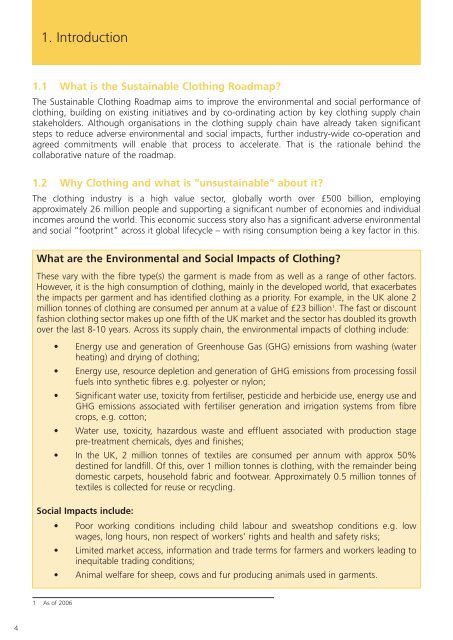SUSTAINABLE CLOTHING ACTION PLAN - Defra
SUSTAINABLE CLOTHING ACTION PLAN - Defra
SUSTAINABLE CLOTHING ACTION PLAN - Defra
Create successful ePaper yourself
Turn your PDF publications into a flip-book with our unique Google optimized e-Paper software.
4<br />
1. Introduction<br />
1.1 What is the Sustainable Clothing Roadmap?<br />
The Sustainable Clothing Roadmap aims to improve the environmental and social performance of<br />
clothing, building on existing initiatives and by co-ordinating action by key clothing supply chain<br />
stakeholders. Although organisations in the clothing supply chain have already taken significant<br />
steps to reduce adverse environmental and social impacts, further industry-wide co-operation and<br />
agreed commitments will enable that process to accelerate. That is the rationale behind the<br />
collaborative nature of the roadmap.<br />
1.2 Why Clothing and what is “unsustainable” about it?<br />
The clothing industry is a high value sector, globally worth over £500 billion, employing<br />
approximately 26 million people and supporting a significant number of economies and individual<br />
incomes around the world. This economic success story also has a significant adverse environmental<br />
and social “footprint” across it global lifecycle – with rising consumption being a key factor in this.<br />
What are the Environmental and Social Impacts of Clothing?<br />
These vary with the fibre type(s) the garment is made from as well as a range of other factors.<br />
However, it is the high consumption of clothing, mainly in the developed world, that exacerbates<br />
the impacts per garment and has identified clothing as a priority. For example, in the UK alone 2<br />
million tonnes of clothing are consumed per annum at a value of £23 billion 1 . The fast or discount<br />
fashion clothing sector makes up one fifth of the UK market and the sector has doubled its growth<br />
over the last 8-10 years. Across its supply chain, the environmental impacts of clothing include:<br />
• Energy use and generation of Greenhouse Gas (GHG) emissions from washing (water<br />
heating) and drying of clothing;<br />
• Energy use, resource depletion and generation of GHG emissions from processing fossil<br />
fuels into synthetic fibres e.g. polyester or nylon;<br />
• Significant water use, toxicity from fertiliser, pesticide and herbicide use, energy use and<br />
GHG emissions associated with fertiliser generation and irrigation systems from fibre<br />
crops, e.g. cotton;<br />
• Water use, toxicity, hazardous waste and effluent associated with production stage<br />
pre-treatment chemicals, dyes and finishes;<br />
• In the UK, 2 million tonnes of textiles are consumed per annum with approx 50%<br />
destined for landfill. Of this, over 1 million tonnes is clothing, with the remainder being<br />
domestic carpets, household fabric and footwear. Approximately 0.5 million tonnes of<br />
textiles is collected for reuse or recycling.<br />
Social Impacts include:<br />
• Poor working conditions including child labour and sweatshop conditions e.g. low<br />
wages, long hours, non respect of workers’ rights and health and safety risks;<br />
• Limited market access, information and trade terms for farmers and workers leading to<br />
inequitable trading conditions;<br />
• Animal welfare for sheep, cows and fur producing animals used in garments.<br />
1 As of 2006

















